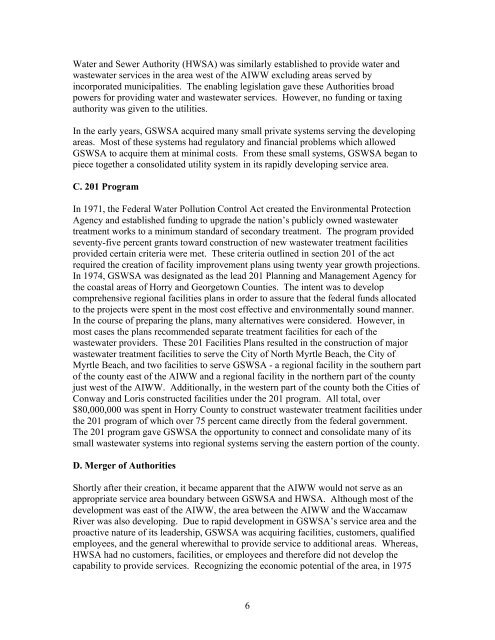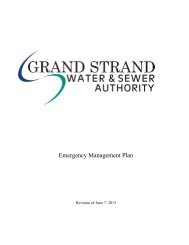2030 Plan - Grand Strand Water and Sewer Authority
2030 Plan - Grand Strand Water and Sewer Authority
2030 Plan - Grand Strand Water and Sewer Authority
You also want an ePaper? Increase the reach of your titles
YUMPU automatically turns print PDFs into web optimized ePapers that Google loves.
<strong>Water</strong> <strong>and</strong> <strong>Sewer</strong> <strong>Authority</strong> (HWSA) was similarly established to provide water <strong>and</strong><br />
wastewater services in the area west of the AIWW excluding areas served by<br />
incorporated municipalities. The enabling legislation gave these Authorities broad<br />
powers for providing water <strong>and</strong> wastewater services. However, no funding or taxing<br />
authority was given to the utilities.<br />
In the early years, GSWSA acquired many small private systems serving the developing<br />
areas. Most of these systems had regulatory <strong>and</strong> financial problems which allowed<br />
GSWSA to acquire them at minimal costs. From these small systems, GSWSA began to<br />
piece together a consolidated utility system in its rapidly developing service area.<br />
C. 201 Program<br />
In 1971, the Federal <strong>Water</strong> Pollution Control Act created the Environmental Protection<br />
Agency <strong>and</strong> established funding to upgrade the nation’s publicly owned wastewater<br />
treatment works to a minimum st<strong>and</strong>ard of secondary treatment. The program provided<br />
seventy-five percent grants toward construction of new wastewater treatment facilities<br />
provided certain criteria were met. These criteria outlined in section 201 of the act<br />
required the creation of facility improvement plans using twenty year growth projections.<br />
In 1974, GSWSA was designated as the lead 201 <strong>Plan</strong>ning <strong>and</strong> Management Agency for<br />
the coastal areas of Horry <strong>and</strong> Georgetown Counties. The intent was to develop<br />
comprehensive regional facilities plans in order to assure that the federal funds allocated<br />
to the projects were spent in the most cost effective <strong>and</strong> environmentally sound manner.<br />
In the course of preparing the plans, many alternatives were considered. However, in<br />
most cases the plans recommended separate treatment facilities for each of the<br />
wastewater providers. These 201 Facilities <strong>Plan</strong>s resulted in the construction of major<br />
wastewater treatment facilities to serve the City of North Myrtle Beach, the City of<br />
Myrtle Beach, <strong>and</strong> two facilities to serve GSWSA - a regional facility in the southern part<br />
of the county east of the AIWW <strong>and</strong> a regional facility in the northern part of the county<br />
just west of the AIWW. Additionally, in the western part of the county both the Cities of<br />
Conway <strong>and</strong> Loris constructed facilities under the 201 program. All total, over<br />
$80,000,000 was spent in Horry County to construct wastewater treatment facilities under<br />
the 201 program of which over 75 percent came directly from the federal government.<br />
The 201 program gave GSWSA the opportunity to connect <strong>and</strong> consolidate many of its<br />
small wastewater systems into regional systems serving the eastern portion of the county.<br />
D. Merger of Authorities<br />
Shortly after their creation, it became apparent that the AIWW would not serve as an<br />
appropriate service area boundary between GSWSA <strong>and</strong> HWSA. Although most of the<br />
development was east of the AIWW, the area between the AIWW <strong>and</strong> the Waccamaw<br />
River was also developing. Due to rapid development in GSWSA’s service area <strong>and</strong> the<br />
proactive nature of its leadership, GSWSA was acquiring facilities, customers, qualified<br />
employees, <strong>and</strong> the general wherewithal to provide service to additional areas. Whereas,<br />
HWSA had no customers, facilities, or employees <strong>and</strong> therefore did not develop the<br />
capability to provide services. Recognizing the economic potential of the area, in 1975<br />
6






